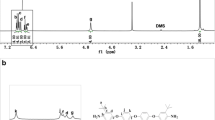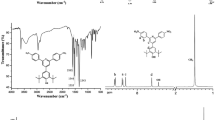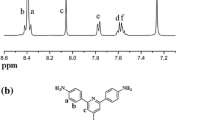Abstract
Four triphenylpyridine diamines with different substituent structure were successfully synthesized and polymerized to obtained polyimides (PIs) via one-step. The diamines and PIs were characterized by FTIR and 1H-NMR spectra. The aggregated structure of PIs was amorphous by wide angle X-ray diffraction test. The structure of the substituent had an important influence on the properties of PI (such as solubility, thermal stability, optical and mechanical properties). The introduction of tert-butyl group could reduce the solubility in non-polar solvent of PI. In addition, the introduction of hydroxyl group alone could increase the solubility in polar solvent of polymer due to the large polarity of the hydroxyl groups. All PIs exhibited high thermal stability and heat resistance, but the introduction of too much tert-butyl group reduced the thermal stability of PI. The introduction of tert-butyl group could effectively improve the optical properties of PIs. The maximum transmittance of PIs was above 85% (87.2–90.3%).









Similar content being viewed by others

References
Yang Y, Lu H, Liu J, Shen Y (2018) Synthesis and binary/ternary write-once read-many-times electrical memory behaviors of carbazole-based polyimides bearing flexible linkage segment. Eur Polym J 108:10–19
Yang Y, Xia J, Ding Z, Zheng Y, Ding S, Shen Y (2018) Synthesis and resistive switching characteristics of polyimides derived from 2,7-aryl substituents tetraphenyl fluorene diamines. Eur Polym J 108:85–97
Park C-Y, Kim E-H, Kim JH, Lee YM, Kim J-H (2018) Novel semi-alicyclic polyimide membranes: synthesis, characterization, and gas separation properties. Polymer 151:325–333
Rehman W, Liaqat K, Fazil S, Saeed S, Waseem M, Shakeel M, Mir S, Bibi I, Guo C-Y (2019) Chemically tethered functionalized graphene oxide based novel sulfonated polyimide composite for polymer electrolyte membrane. J Polym Res 26:82
Wang N, Chen Y, Ren J, Huang X, Chen X, Li G, Liu D (2017) Electrically conductive polyaniline/polyimide microfiber membrane prepared via a combination of solution blowing and subsequent in situ polymerization growth. J Polym Res 24:42
Ignat M, Ovezea D, Hamciuc E, Hamciuc C, Dimitrov L (2014) Study on the electromechanical properties of polyimide composites containing TiO 2 nanotubes and carbon nanotubes. J Polym Res 21:536
Wang Z, Li S, Wang J, Han E, Tian G, Wu D (2020) Dielectric and mechanical properties of polyimide fiber reinforced cyanate ester resin composites with varying resin contents. J Polym Res 27:160
Koolivand H, Sharif A, Kashani M-R, Karimi M, Salooki M-K, Semsarzadeh M-A (2014) Functionalized graphene oxide/polyimide nanocomposites as highly CO2-selective membranes. J Polym Res 21:599
Wang Y-W, Chen W-C (2011) New photosensitive colorless polyimide-silica hybrid optical materials: synthesis, properties and patterning. Mater Chem Phys 126:24–30
Sun Z, Qin A, Chen Z, Wang Y (2010) Large pretilt angle induced by an anhydride-terminal hyperbranched polyimide liquid crystal alignment layer. Liq Cryst 37(3):345–348
Okulska-Bozek M, Prot T, Borycki J, Kedzierski J (2006) Preparation and evaluation of polyimide layers as materials for nematic liquid crystal orientation. Liq Cryst 20(3):349–359
Ghosh A, Sen SK, Banerjee S, Voit B (2012) Solubility improvements in aromatic polyimides by macromolecular engineering. RSC Adv 2:5900–5926
Chern Y-T, Twu J-T, Chen J-C (2009) High Tg and high organosolubility of novel polyimides containing twisted structures derived from 4-(4-amino-2-chlorophenyl)-1-(4-aminophenoxy)-2,6-di-tert-butylbenzene. Eur Polym J 45(4):1127–1138
Liu Y, Zhang Y, Guan S, Li L, Jiang Z (2008) Synthesis and properties of soluble fluorinated poly(ether imide)s with different pendant groups. Polymer 49(25):5439–5445
Lu Y, Wu Y, Xiao G, Dong Y, Zhao H, Hu Z (2014) Synthesis and characterization of poly(pyridine–imide)s with tert-butyl substituents. Adv Polym Sci 26(5):561–568
Gu Y, Sun Z, Gong S, Zhang H, Gong Q, Liu L, Wang Y (2015) Synthesis and characterization of soluble and thermally stable triphenylpyridine-containing aromatic polyimides. J Mater Sci 50:6552–6558
Sun Z, Liu M, Yi L, Wang Y (2013) High glass transition of organo-soluble copolyimides derived from a rigid diamine with tert-butyl-substituted triphenylpyridine moiety. RSC Adv 3:7271
Zamidi Ahmad M, Navarro M, Lhotka M, Zornoza B, Téllez C, Fila V, Coronas J (2018) Enhancement of CO2/CH4 separation performances of 6FDA-based CO-polyimides mixed matrix membranes embedded with UiO-66 nanoparticles. Sep Purif Technol 192:465–474
C-P YANG, R-S CHEN, K-H CHEN (2003) Effects of Diamines and their fluorinated groups on the color lightness and preparation of Organosoluble aromatic polyimides from 2,2-Bis[4-(4-amino-2- trifluoromethylphenoxy)phenyl]-hexafluoropropane. J Polym Sci Pol Chem 41(7):922–938
Li Y, Xu H, Tao X, Qian K, Fu S, Shen Y, Ding S (2011) Synthesis and memory characteristics of highly organo-soluble polyimides bearing a noncoplanar twisted biphenyl unit containing aromatic side-chain groups. J Mater Chem 21:1810–1821
Yan S, Chen W, Yang X, Chen C, Huang M, Xu Z, Yeung KWK, Yi C (2010) Soluble polyimides based on a novel pyridine-containing diamine m,p-PAPP and various aromatic dianhydrides. Polym Bull 66:1191–1206
Chern Y-T, Tsai J-Y (2008) Low dielectric constant and high Organosolubility of novel polyimide derived from Unsymmetric 1,4-Bis(4-aminophenoxy)-2,6-di-tert-butylbenzene. Macromolecules 41:9556–9564
Chern Y-T, Ju M-H (2009) Conformation of polyimide backbone structures for determination of the Pretilt angle of liquid crystals. Macromolecules 42:169–179
Huang W, Yan D, Lu Q (2001) Synthesis and characterization of a highly soluble aromatic polyimide from 4,49-Methylenebis(2-tertbutylaniline). Macromol Rapid Commun 22:1481–1484
Acknowledgements
This work was supported by the National Natural Science Foundation of China (Grant No. 51173115).
Author information
Authors and Affiliations
Corresponding author
Additional information
Publisher’s note
Springer Nature remains neutral with regard to jurisdictional claims in published maps and institutional affiliations.
Rights and permissions
About this article
Cite this article
Yuan, C., Sun, Z. & Wang, Y. Study on the effect of different amounts of hydroxyl and tert-butyl substituted triphenylpyridine units on the properties of polyimide. J Polym Res 27, 193 (2020). https://doi.org/10.1007/s10965-020-02175-5
Received:
Accepted:
Published:
DOI: https://doi.org/10.1007/s10965-020-02175-5



